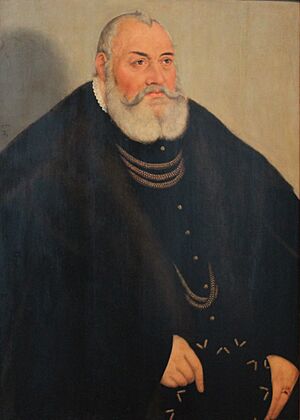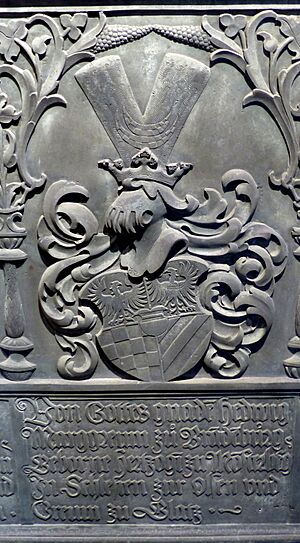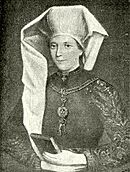George, Margrave of Brandenburg-Ansbach facts for kids
Quick facts for kids George the Pious |
|
|---|---|

Portrait by Hans Krell (1522)
|
|
| Margrave of Ansbach | |
| Reign | 1536–1543 |
| Predecessor | Frederick I |
| Successor | George Frederick |
| Born | 4 March 1484 Ansbach |
| Died | 27 December 1543 (aged 59) Ansbach |
| Spouse |
Beatrice de Frangepan
(m. 1509; died 1510)Hedwig of Münsterberg-Oels
(m. 1525; died 1531)Emilie of Saxony
(m. 1533) |
| Issue |
|
| House | Hohenzollern |
| Father | Frederick I, Margrave of Brandenburg-Ansbach |
| Mother | Sophia of Poland |
George of Brandenburg-Ansbach (born March 4, 1484 – died December 27, 1543) was a powerful ruler from the House of Hohenzollern. He was also known as George the Pious because of his strong religious beliefs. He served as a Margrave of Brandenburg-Ansbach.

Contents
Early Life and Royal Connections
George was born in Ansbach, a city in Germany. He was the second of eight sons born to Margrave Frederick the Elder and his wife Sophia of Poland. His mother, Sophia, was the daughter of Casimir IV of Poland, a king. This meant George had important family connections to the royal court in Buda, which is now part of Budapest, Hungary.
In 1506, George began working for his uncle, King Vladislaus II of Bohemia and Hungary. The king treated George like his own son. In 1515, George was given control of the Duchy of Oppeln. A year later, in 1516, he became part of the special government that looked after Hungary. He also became the tutor for the king's son, Louis II of Hungary and Bohemia.
Expanding His Influence
George's power grew even more when he gained control of other lands. He took over the duchies of Ratibor and Oppeln through special agreements. He also gained control of areas like Oderberg, Beuthen, and Tarnowitz. These lands were given to him as a promise from the king of Bohemia because the king couldn't pay his debts.
Later, George also took over the Duchy of Jägerndorf. This meant he owned or controlled almost all of Upper Silesia, a large region. As a ruler of these lands, George played a big part in bringing the Protestant Reformation to these areas. He was one of the first German princes to support the new Protestant faith. Even his younger brother, Albert, who was a leader of the Teutonic Knights, followed George's lead in this.
Embracing the Reformation
George became very interested in the new ideas of the Reformation, which started in Wittenberg. He was deeply moved by Martin Luther's strong beliefs at the Diet of Worms in 1521. He also listened to powerful sermons in Nuremberg in 1522. Reading Luther's translation of the New Testament helped him truly believe in the new faith.
George even wrote letters to Luther, asking him about important religious questions. In 1524, they met in person. They talked about George's brother Albert's plan to change the Teutonic Order's state of Prussia into a regular country.
Spreading the New Faith
When King Louis II came to power, George got help from Queen Maria. She was the sister of powerful rulers like Charles V and Ferdinand I. Queen Maria also liked the new Protestant ideas. As an advisor to the young king, George strongly supported the new gospel. He stopped his opponents from using violence against the new faith.
George also worked with other dukes who had already accepted the Reformation in their lands. This helped the new faith spread in his own territories. But it was George's own strong will and practical approach that truly brought the new teachings to his lands. He found preachers from different regions to spread the gospel. He also tried to introduce a new church system, which was already used in other areas.
Reformation in Franconia
In his home region of Brandenburg-Ansbach in Franconia, George faced more challenges. He was ruling alongside his older brother, Casimir. Casimir was more connected to the old church because of his marriage and military service. He resisted the new reform efforts at first.
However, the people of the land soon pushed Casimir to allow preaching based on Luther's ideas. Still, Casimir wanted to keep some of the old church ceremonies, even those that went against the new faith. George disagreed with these half-measures.
After his brother Casimir died, George became the sole ruler. He was then able to fully bring the Reformation to the Franconian territories. He got help from his advisors and new decisions made by the local assembly in 1528. George continued to write to Luther and other reformers like Philipp Melanchthon. They discussed important topics like how to use church property for good purposes. They also talked about setting up schools for everyone and higher schools for talented young men. These schools would train people for serving the church and the state.
George worked closely with the Council of Nuremberg to create a new church order. This order, called the church order of Brandenburg-Nuremberg, was finished in 1533. After it was used in Nuremberg and his lands in Franconia, it was also introduced in his territories in Upper Silesia.
Wider Influence
George's influence was important for the German Reformation as a whole. When Protestant leaders thought about joining together for better protection, George met with Elector John of Saxony in 1529. They agreed on certain beliefs that Luther would write down. These ideas became the articles of Schwabach.
However, George did not support fighting against the emperor, even in self-defense. At the Diet of Augsburg in 1530, the emperor wanted to stop Protestant preaching. George strongly opposed this. King Ferdinand offered George many lands in Silesia if he would support the emperor. But George firmly refused these offers. He stood out as one of the main princes who defended the reformed faith, second only to the elector of Saxony.
After his cousin, Joachim I, who was a strict Catholic, died, George helped Joachim's sons. He assisted them in bringing the Reformation to the lands of the Electorate of Brandenburg. George also took part in the religious colloquy of Regensburg in 1541. This was a meeting where people tried to find common ground between Catholics and Lutherans. The Diet of Regensburg was the last religious meeting George attended.
George is also shown in a famous painting called Prussian Homage by Jan Matejko.
Family Life
George was married three times and had several children.
His first marriage was to Beatrice de Frangepan in 1509. They did not have any children.
His second marriage was to Hedwig of Münsterberg-Oels in 1525. They had two daughters:
- Anna Maria of Brandenburg-Ansbach (born 1526 – died 1589); she married Christoph, Duke of Württemberg.
- Sabina of Brandenburg-Ansbach (born 1529 – died 1575); she married John George, Elector of Brandenburg.
His third wife was Emilie of Saxony, whom he married in 1533. They had four children:
- Sophie of Brandenburg-Ansbach (born 1535 – died 1587); she married Henry XI of Legnica.
- Barbara of Brandenburg-Ansbach (born 1536 – died 1591).
- Dorothy Catherine of Brandenburg-Ansbach (born 1538 – died 1604); she married Henry V of Plauen.
- George Frederick (born 1539 – died 1603); he later became Margrave of Brandenburg-Ansbach and a regent for the Duchy of Prussia.




